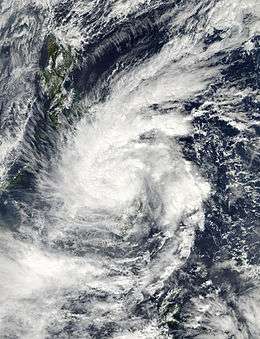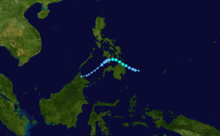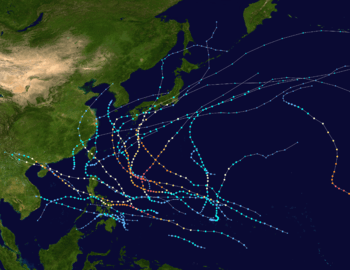Tropical Storm Jangmi (2014)
| Tropical storm (JMA scale) | |
|---|---|
| Tropical storm (Saffir–Simpson scale) | |
 Jangmi over the Philippines on December 29 | |
| Formed | December 28, 2014 |
| Dissipated | January 1, 2015 |
| Highest winds |
10-minute sustained: 75 km/h (45 mph) 1-minute sustained: 85 km/h (50 mph) |
| Lowest pressure | 996 hPa (mbar); 29.41 inHg |
| Fatalities | 66 confirmed |
| Damage | $28.3 million (2014 USD) |
| Areas affected | Philippines, Borneo |
| Part of the 2014 Pacific typhoon season | |
Tropical Storm Jangmi, known in the Philippines as Tropical Storm Seniang, was a weak but destructive tropical cyclone that impacted the Philippines during late December 2014. It produced heavy rainfall which caused serious flooding. Flooding in Philippines caused 66 deaths and at least $28.3 million damage.[1]
The last of twenty-three named storms of the annual typhoon season, the late-season cyclone remained weak throughout most of its lifespan. The tropical storm reached peak strength on December 29 near Surigao del Sur, Mindanao.[2] Jangmi dissipated just before the 2015 Pacific typhoon season started.
Meteorological history

On December 26, both the JTWC and PAGASA started to monitor a tropical disturbance well east of Mindanao, Philippines just where Sinlaku formed. On December 27, the JMA started to monitor a tropical depression, that had developed within favourable conditions for further development, about 630 km (390 mi) to the west of Koror, Palau.[3][4] Over the next day the depression gradually developed further and was named Seniang by PAGASA as it moved northwesterly along a ridge of high pressure, while atmospheric convection wrapped into the system's low level circulation centre.[5][6] Both the JTWC and PAGASA upgraded the depression to a tropical storm late on the same day.
Early on December 29, the JMA upgraded the system to a tropical storm, naming it Jangmi. At the time of the upgrade, Jangmi made landfall over the town of Hinatuan in the province of Surigao del Sur. The storm traversed the CARAGA region, and exited the landmass of Mindanao during the afternoon hours of the same day, as it had accelerated to the northwest. Late on December 30, Jangmi made landfall over Cebu and southern Negros, right before the JTWC downgraded it to a tropical depression. On December 31, the JTWC issued the final warning to Jangmi, and the JMA downgraded it to a tropical depression at noon the same day. The system was last noted by the JMA and the JTWC on January 1, 2015, dissipating over Borneo, just before the 2015 Pacific typhoon season started.
Impact
Philippines
| Effect of TS Seniang (Jangmi) on the Philippines | |||||||||||||||||||||||||||||||||||||||||||||||||||||||||||||||||||||
|---|---|---|---|---|---|---|---|---|---|---|---|---|---|---|---|---|---|---|---|---|---|---|---|---|---|---|---|---|---|---|---|---|---|---|---|---|---|---|---|---|---|---|---|---|---|---|---|---|---|---|---|---|---|---|---|---|---|---|---|---|---|---|---|---|---|---|---|---|---|
| |||||||||||||||||||||||||||||||||||||||||||||||||||||||||||||||||||||
| Source [1] | |||||||||||||||||||||||||||||||||||||||||||||||||||||||||||||||||||||
Tropical Storm Jangmi made landfall in Surigao del Sur on December 29.[2][7] It produced heavy rains and caused flooding in Southern Philippines.[8]
In Malacañang, PCOO Secretary Coloma defended the government from criticism that not enough was done to prevent the high casualty count, saying agencies gave timely warnings and that President Aquino had directed government to mobilize all resources to help the victims.[8]
Retirement
Because the total cost of damage reached at least ₱ 1 billion, the name Seniang was retired by PAGASA, and replaced by Samuel for the 2018 season.[9][10]
See also
Notes
- ↑ Damages of agriculture according to the NDRRMC include crops, livestocks, high-value commercial crops (HVCC) and fisheries.
References
- 1 2 "SitRep No. 22 re Effects of Tropical Storm SENIANG". National Disaster Risk Reduction and Management Council. January 10, 2015. Archived from the original (PDF) on February 27, 2015. Retrieved January 10, 2015.. Similarly to Tropical Storm Sinlaku but it is Minimal Winds than Jangmi. But Sinlaku is struck on Mindanao in Late November. But Jangmi is struck on Late December/
- 1 2 "'Seniang' now a tropical storm; makes landfall". Sun Star. December 29, 2014. Retrieved January 9, 2015.
- ↑ "JMA WWJP25 Warning and Summary December 27, 2014 06z". Japan Meteorological Agency. December 27, 2014. Archived from the original on December 27, 2014. Retrieved January 1, 2015.
- ↑ Joint Typhoon Warning Center. "Significant Tropical Weather Advisory for the Western and South Pacific Oceans December 27, 2014 06z". United States Navy, United States Airforce. Archived from the original on December 28, 2014. Retrieved January 1, 2015.
- ↑ Joint Typhoon Warning Center (December 28, 2014). "Prognostic Reasoning for Tropical Depression 23W December 28, 2014 03z". United States Navy, United States Airforce. Archived from the original on December 28, 2014. Retrieved January 1, 2015.
- ↑ "Severe Weather Bulletin Number One Tropical Cyclone Warning: Tropical Depression "Seniang", December 27, 2014 21z". Philippine Atmospheric, Geophysical and Astronomical Services Administration. July 5, 2014. Archived from the original on January 2, 2015. Retrieved January 2, 2015.
- ↑ "SitRep No. 2 re Effects of Tropical Storm SENIANG" (PDF). National Disaster Risk Reduction and Management Council. December 29, 2014. Retrieved January 8, 2015.
- 1 2 "At least 54 dead, mostly from slides, floods in Visayas, Mindanao". Interaksyon. December 31, 2014. Retrieved January 1, 2015.
- ↑ "Pagasa kills names of killer typhoons". Philippine Daily Inquirer. February 8, 2015. Archived from the original on February 9, 2015. Retrieved February 9, 2015.
- ↑ "Philippine Tropical Cyclone Names". Philippine Atmospheric, Geophysical and Astronomical Services Administration. Retrieved February 1, 2015.
External links
| Wikimedia Commons has media related to Tropical Storm Jangmi (2014). |
- JMA General Information of Tropical Storm Jangmi (1423) from Digital Typhoon
- JMA Best Track Data of Tropical Storm Jangmi (1423) (Japanese)
- 01W.LINGLING from the U.S. Naval Research Laboratory
